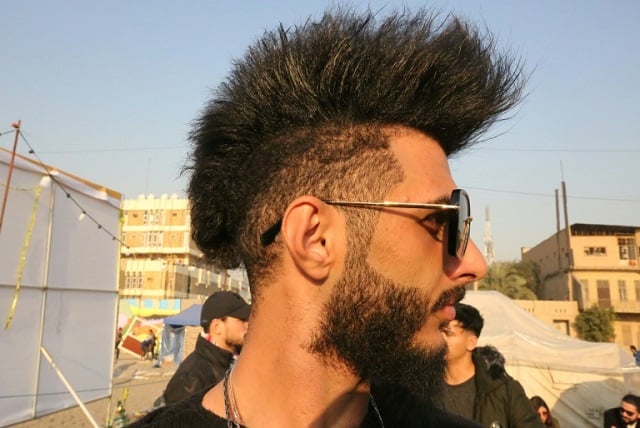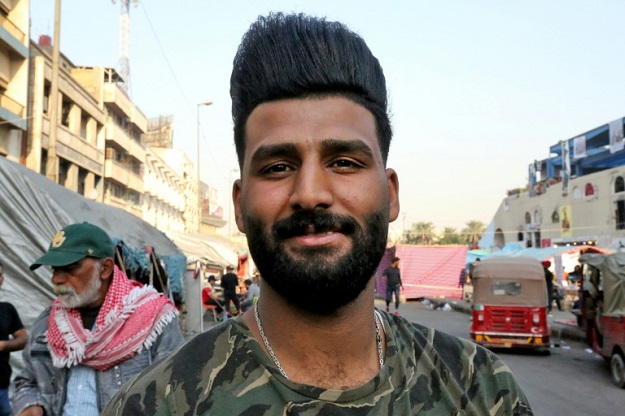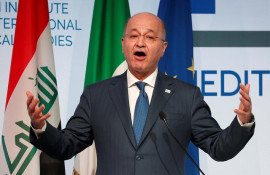
BAGHDAD: Elvis Presley may have been the advance guard, but young Iraqis own it -- protesters in Baghdad sport slicked styles and rockabilly haircuts, a testament to their unyielding rebel spirit.
"The revolution has changed everything," said Qassem, nearly three months into a popular movement that seeks to unseat Iraq's highly dysfunctional political establishment.
"Now, it is all so different -- we are free," the young protester added under a tent where he doles out tea and biscuits to peers in Tahrir Square.
"We also know how to let loose," Qassem continued, his face switching suddenly from serious to smiling.
 PHOTO: AFP
PHOTO: AFPThousands protest in Iraq as deadline for new PM looms
"And so I invented a new style," he chuckled, glancing upwards towards his rectangular pompadour.
Outside his tent, thousands of students and young unemployed people thronged the iconic square, railing once more against "crooked" politicians.
Their enthusiasm has remained undimmed since the start of the revolt on October 1, despite clashes with security forces that have killed close to 460.
One thing strikes the eye perhaps above all else is the unbridled hairstyles young men sport.
High quiffs, tight fades and loads of attitude -- it is quite the male beauty pageant.
Exclusively male and in large part inspired by the fashionable cuts of football stars, the phenomenon is coursing through the Arab world.
And it is particularly exuberant in Tahrir Square.
"Here, we call it the rooster comb," explained a local journalist.
For 23-year-old actor and renowned activist Omar Dabbour, "the style began two years ago".
Then "it exploded with the revolution in Tahrir. The people feel increasingly free," he noted.
Dabbour himself sports an impressive, albeit more natural, style -- an afro worthy of the Jackson Five, which amounts to a radical departure, in what is otherwise an ocean of hair gel.
"In Tahrir Square, young people are daring -- it has become normal," added Dabbour.
"But in the rest of the city, it's a bit different -- more conservative. There is the army, the militiamen who can bother you at checkpoints," he continued.
"I don't care. Before, I had a short haircut. Now I have let it grow. Why be scared?"
Sporting yellow tinted glasses and maintaining a studious air, Karrar Riad, 20, pushed a hand through his long and deliberately disordered locks.
With a black leather bracelet, he has the air of a young Johnny Depp. "Today, everything is possible. We do what we want here," he said.
Here perhaps, but not in Riad's home district of Kadhimiya, which houses a key Shiite mausoleum.
 PHOTO: AFP
PHOTO: AFPGoing home requires him to restore some conventional order to his unruly mop.
Other fashionistos don a cap to blend back in when they depart the protest hotbed.
Their caution is not without reason.
In 2012, at least 15 youths were stoned, beaten or shot to death in a spate of targeted attacks against people sporting the "emo" look -- tight-fitting black clothes and alternative hairstyles.
The range of styles is wide, but it is Iraq's take on the Elvis cut that rises head and shoulders above the rest: a towering pompadour with undercut back and sides.
"Adopted by celebrities, students and hipsters," the pompadour -- named after a mistress of French King Louis XV -- will transform you into a "sexy and trendy man", according to one website.
But this style itself unfurls into a multitude of sub-styles in Iraq, from classic rockabilly to even the mohawk.
And amid the proliferation of looks, cuts are becoming ever more voluminous.
"The idea is to do what you want to do," said Dabbour.
And probably also to attract the throngs of young women who frequent Tahrir Square, in a commingling that is unusual in Iraq.
The hair styles on display have "roots in the 1990s, in the hairdressing salons and male beauty parlours of Sadr City," explained Zahraa Ghandour, an Iraqi documentary film maker.
Sadr City -- a huge working-class district of northeastern Baghdad -- was marginalised under the regime of deposed dictator Saddam Hussein.
"The residents wanted to mark themselves out. It was a means to express themselves, to protest," said Ghandour.
Baroque haircuts, meanwhile, "really started around two years ago, again in Sadr city."
Zouheir-al-Atouani, a local videographer who has gained nationwide fame, spread this style by posting wedding videos in which men sport ever more sculpted looks.
According to Ghandour, "in Tahrir, ever more frequented by young people from Sadr city, it's a way to rebel, to free oneself".
Pompeo warns Iran of 'decisive response' if harm in Iraq
It is also most likely a way of defying the country's all-powerful militias, and social revenge for young people who feel despised, yet now find themselves at the forefront of fashion.
"They are especially creative," smiles Ghandour.
And the styles are "spread far and wide by social networks", where dandies love to showcase their ever crazier cuts.



































































COMMENTS
Comments are moderated and generally will be posted if they are on-topic and not abusive.
For more information, please see our Comments FAQ